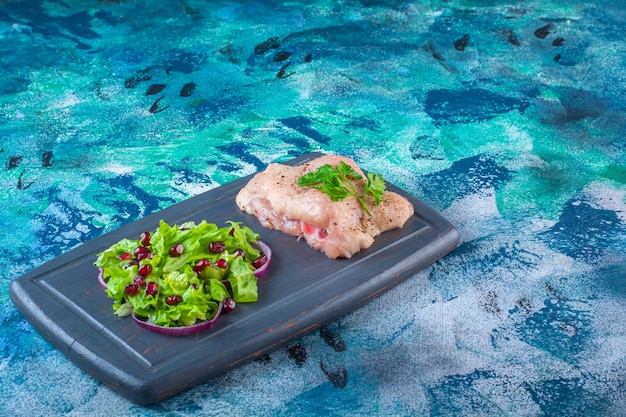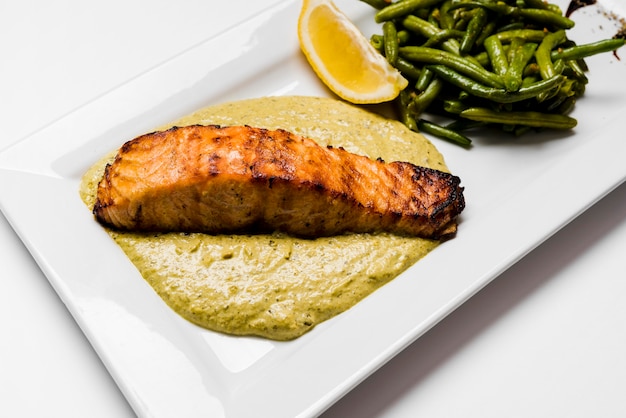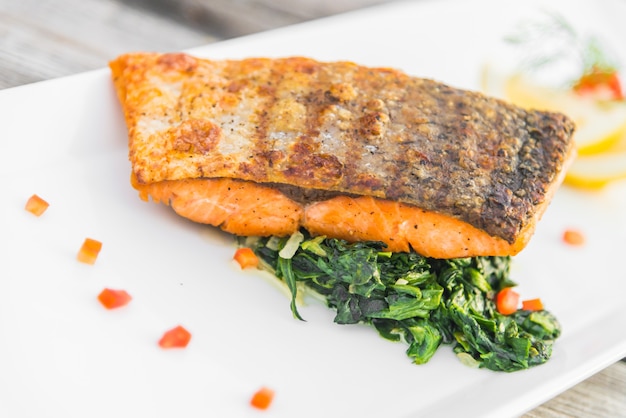Part 1: Choosing the Perfect Swordfish

The Look and Feel:
Freshness is key: Fresh swordfish should have a bright, silvery-blue colour, almost shimmering. You want a fish that's firm to the touch, not flabby or mushy. Imagine the texture of a well-done piece of chicken breast. Avoid any funny business: Give the fish a good sniff. It should have a fresh, mild scent, not a strong, fishy smell. Check for any signs of discolouration or bruising. The flesh should be uniform in colour. Eyes and Gills: If you're buying whole swordfish, check the eyes. They should be clear and bright. The gills should be red and moist. These are good indicators of freshness. The thickness matters: If you’re aiming for a perfectly cooked steak, go for a piece that’s about an inch thick. This will ensure that it cooks evenly and doesn't become dry on the outside while still raw in the middle.The Cuts:
The Classic Steak: This is your standard, straightforward cut, perfect for grilling or pan-frying. It’s typically cut from the thicker, more muscular part of the fish and has a nice, even thickness. The Butterfly Cut: A thicker cut, typically sold with the bone still in. It gets its name from the way it's cut, where the flesh is folded over itself like a butterfly. This cut can be a bit trickier to cook, requiring a bit more time and attention, but it's great for grilling or roasting. The Medallions: These are small, circular cuts, ideal for quick cooking methods like sautéing. They're perfect for a light and quick meal, as they cook very quickly.Storage:
Refrigerate properly: If you can’t cook your swordfish straight away, keep it refrigerated, wrapped tightly in plastic wrap or foil. This will help to prevent it from drying out. Freezing options: If you need to freeze it, make sure to wrap it tightly in freezer-safe plastic wrap. Freezing can affect the texture of the fish slightly, so it's best to thaw it slowly in the refrigerator before cooking.Part 2: The Preparation Process

Prepping Your Swordfish:
1. Remove the skin: If you’re planning on grilling or pan-frying, remove the skin. This will help the fish cook more evenly and also creates a nice, crispy surface. You can do this by gently pulling the skin away from the meat. If the skin feels a bit stubborn, you can use a sharp knife to score the skin, which will make it easier to remove.
2. Seasoning your swordfish: This is where things get exciting. You can go simple with a sprinkle of salt and pepper, or get creative with your seasonings. I love a good rub of paprika, garlic powder, and a squeeze of lemon juice. Just remember to season generously. You can always add more flavour later.
3. Marinate for extra flavour: You can take your swordfish to the next level with a marinade. I’ll share a few of my favourite recipes later on, but for now, just remember that marinades can help to tenderise the fish and add a whole new dimension of flavour. Look for a marinade with acidic ingredients like lemon juice, lime juice, or vinegar. These help to break down the proteins in the fish, making it more tender. Just be sure to let the swordfish marinate for at least 30 minutes, or up to a few hours, before cooking.
Part 3: Cooking Your Swordfish to Perfection

Grilling:
The ideal heat: Get your grill nice and hot, around medium-high heat. You want the grill grates to be hot enough to sear the fish quickly, creating those beautiful grill marks. Don’t overcrowd: Give your swordfish some space on the grill. If you crowd the grill, it’ll cool down, and your fish will steam instead of sear. You want to maintain that high heat to cook the fish evenly. Grill marks: Make sure you get those lovely grill marks. Just flip the fish once it’s cooked through about halfway. You'll know it's ready to flip when the flesh turns opaque and begins to flake easily. Timing is everything: A 1-inch thick steak will take about 4-6 minutes per side, depending on how you like it cooked. Don't overcook it! It's easy to go from perfectly cooked to dry and tough in a matter of seconds. Rest time is essential: Let the fish rest for a few minutes before slicing. This will help the juices redistribute, giving you a juicier steak.Pan-frying:
The right pan: Use a heavy-bottomed pan, preferably cast iron, for even heat distribution. You want a pan that will hold heat well and prevent the fish from sticking. Get the pan hot: Heat the pan over medium-high heat until it’s shimmering. You want to be able to see a ripple of heat in the oil. Add the oil: You’ll need a bit of oil, but not too much. Just enough to coat the bottom of the pan. A high-heat oil like grapeseed or avocado oil works well. Sizzle it up: Add your swordfish and cook for about 3-4 minutes per side. You want to hear a satisfying sizzle as the fish hits the pan. This means the pan is hot enough. Rest is still important: Let the fish rest for a few minutes before serving. This allows the juices to redistribute, giving you a more tender and flavorful steak.Baking:
Preheat your oven: Pre-heat the oven to 400 degrees Fahrenheit (200 degrees Celsius). This will ensure that the fish cooks evenly throughout. Line the baking sheet: Line a baking sheet with parchment paper. This will prevent the fish from sticking to the baking sheet. Cook time: Bake for 10-15 minutes, or until the fish is cooked through. You want the fish to be opaque and flake easily. Check for doneness: Use a fork to gently pierce the thickest part of the fish. If the fish flakes easily, it's cooked through. You can also use a meat thermometer to check the internal temperature. Aim for 145 degrees Fahrenheit (63 degrees Celsius).Part 4: Doneness and Tips
Knowing when your swordfish is cooked to your liking is key. Here’s what you need to know:Doneness:
Rare: The fish will be translucent in the centre. This is for those who like their fish very tender and with a slightly raw texture. Medium-rare: The fish will be pink in the centre. This is a popular choice, offering a balance of tenderness and cooked flavour. Medium: The fish will be white throughout. This is a good choice if you prefer a more cooked fish texture. Well-done: The fish will be opaque and flaky. This is for those who like their fish cooked all the way through.Tips for Cooking:
- Don't overcook! Swordfish can get dry and tough if overcooked, so it's best to err on the side of undercooking. It's better to have a slightly pink center than a dry and crumbly steak.
- Use a thermometer: A meat thermometer is a great way to ensure your swordfish is cooked to your liking. Insert the thermometer into the thickest part of the fish, and aim for an internal temperature of 145 degrees Fahrenheit (63 degrees Celsius). This is the recommended temperature for safe consumption.
- Rest your fish: Let your swordfish rest for a few minutes after cooking. This will allow the juices to redistribute and make your fish extra moist. This is especially important for grilled or pan-fried swordfish, as the juices will run if you cut into it immediately.
- Keep it simple: Swordfish has a lovely flavour on its own, so don't be afraid to keep it simple. Season it with just salt and pepper, and you'll be amazed at how delicious it is.
Part 5: side dishes and Sauces
Now, let's talk sides and sauces. This is where the fun really begins.Side Dishes:
- grilled vegetables: A classic combination. Try zucchini, peppers, and onions, grilled with a little olive oil and herbs. The smoky flavour of grilled vegetables complements the rich flavour of swordfish perfectly.
- Roasted Potatoes: A hearty and comforting side. Try roasted potatoes with herbs, garlic, or even a sprinkle of paprika for a kick. Roasted potatoes add a satisfying texture and earthy flavour to your meal.
- Risotto: A creamy and indulgent side dish that pairs beautifully with swordfish. Try a classic lemon risotto or a creamy mushroom risotto. The rich, creamy texture of risotto contrasts beautifully with the firm texture of swordfish.
- Couscous: A light and fluffy side dish that's perfect for a warm summer evening. Add some fresh herbs, lemon zest, and a drizzle of olive oil for extra flavour. Couscous is a versatile grain that can be dressed up or down, and it's a great way to add some lightness to your meal.
- Salad: A refreshing and light option. Try a salad with grilled vegetables, a vinaigrette dressing, and a sprinkle of crumbled feta cheese. The crispness of the salad contrasts nicely with the rich, meaty flavour of the swordfish.
Sauces:
- Lemon Butter Sauce: A simple but elegant sauce that enhances the flavour of the fish. Simply melt butter in a pan, add lemon juice, and season with salt and pepper. The tangy lemon juice cuts through the richness of the fish, while the butter adds a creamy texture.
- Tomato Salsa: A vibrant and tangy sauce that adds a burst of flavour. Try a homemade salsa with fresh tomatoes, onions, cilantro, and lime juice. The acidity of the lime and tomato helps to balance the richness of the fish.
- Aioli: A creamy garlic sauce that adds a spicy kick. Aioli is a delicious way to add a touch of garlic and spice to your swordfish. You can buy it pre-made, or you can make your own with mayonnaise, garlic, lemon juice, and salt.
Part 6: Swordfish Steak Recipes
Now, let’s get into some recipes. I've got a few of my favourites to share with you.Recipe 1: grilled swordfish with Lemon Herb Sauce
Ingredients:
- 1 pound swordfish steak, about 1 inch thick
- 1 tablespoon olive oil
- 1 teaspoon salt
- 1/2 teaspoon black pepper
- 1/4 cup butter
- 1/4 cup chopped fresh parsley
- 1/4 cup chopped fresh dill
- 2 tablespoons lemon juice
Instructions:
- Preheat grill to medium-high heat. Make sure the grates are clean and oiled.
- Rub swordfish steak with olive oil, salt, and pepper.
- Grill swordfish for 4-6 minutes per side, or until cooked through. You'll know it's cooked when the flesh turns opaque and flakes easily.
- Meanwhile, melt butter in a small saucepan over medium heat. Add parsley, dill, and lemon juice. Simmer for a minute to allow the flavors to meld.
- Pour sauce over swordfish and serve immediately.
Recipe 2: Pan-Seared Swordfish with Tomato Salsa
Ingredients:
- 1 pound swordfish steak
- 1 tablespoon olive oil
- 1/2 teaspoon salt
- 1/4 teaspoon black pepper
- 1 cup chopped tomatoes
- 1/2 cup chopped red onion
- 1/4 cup chopped cilantro
- 2 tablespoons lime juice
- 1/4 teaspoon salt
- 1/8 teaspoon black pepper
Instructions:
- Heat olive oil in a large skillet over medium-high heat. You want the pan to be hot enough to create a nice sear on the fish.
- Season swordfish steak with salt and pepper.
- Add swordfish to skillet and cook for 3-4 minutes per side, or until cooked through. You want a beautiful golden brown crust on the fish.
- Meanwhile, in a medium bowl, combine tomatoes, red onion, cilantro, lime juice, salt, and pepper. Let the salsa sit for a few minutes to allow the flavors to meld.
- Top swordfish with tomato salsa and serve immediately.
Recipe 3: baked swordfish with Garlic Herb Sauce
Ingredients:
- 1 pound swordfish steak
- 1 tablespoon olive oil
- 1 teaspoon salt
- 1/2 teaspoon black pepper
- 2 tablespoons butter
- 2 cloves garlic, minced
- 1/4 cup chopped fresh parsley
- 1/4 cup chopped fresh thyme
- 1/4 cup white wine
- 1 tablespoon lemon juice
Instructions:
- Preheat oven to 400 degrees Fahrenheit (200 degrees Celsius).
- Rub swordfish steak with olive oil, salt, and pepper.
- Place swordfish on a baking sheet lined with parchment paper.
- Bake for 10-15 minutes, or until cooked through. You want the fish to be opaque and flake easily.
- Meanwhile, melt butter in a small saucepan over medium heat. Add garlic, parsley, and thyme. Cook for 1 minute, or until fragrant.
- Add white wine and lemon juice. Bring to a simmer and cook for 1 minute, or until the sauce has thickened slightly.
- Pour sauce over swordfish and serve immediately.
Part 7: Swordfish Steak: A culinary adventure
Look, I'm not just telling you this because I'm a bit of a foodie (although that’s definitely part of it). There's something truly special about swordfish. It’s got a rich, slightly sweet flavour that's perfect for both simple and elaborate dishes. And once you've got the basics down, you can really go wild with the flavours and spices. Think about it: you could have a Mediterranean-inspired swordfish steak with olives and capers, or a spicy Caribbean-inspired dish with jerk seasoning. The possibilities are endless. And that’s what makes cooking with swordfish so much fun.Part 8: FAQs
Here are a few answers to some of the most common questions I get about swordfish.1. What does swordfish taste like?
Swordfish has a firm, meaty texture and a rich, slightly sweet flavour. It's often described as tasting similar to tuna or mahi-mahi, but with a slightly more pronounced flavour. Think of a slightly richer, more intense tuna with a hint of sweetness.2. Is swordfish healthy?
Swordfish is a great source of protein and omega-3 fatty acids. However, it is also a predator fish, so it can contain higher levels of mercury than some other types of fish. If you are pregnant, breastfeeding, or have concerns about mercury levels, it's best to consult with your doctor about how much swordfish is safe for you to eat. The FDA recommends limiting consumption of swordfish to no more than 4 ounces per week for adults.3. How can I tell if swordfish is bad?
Fresh swordfish should have a bright, silvery-blue colour, be firm to the touch, and have a fresh, mild scent. If the fish has a dull colour, is soft or mushy, or has a strong, fishy smell, it's likely bad and should be discarded.4. What are some other ways to cook swordfish?
While grilling, pan-frying, and baking are the most popular methods, you can also cook swordfish in other ways, like:- Poaching: Poaching swordfish in a flavorful broth can result in a delicate and moist dish. This method is perfect for preserving the natural flavour of the fish and adding a subtle flavour from the broth.
- Searing: Quickly searing swordfish in a hot pan creates a crispy crust and a juicy interior. This method is perfect for bringing out the flavour of the fish and creating a delicious textural contrast.
- Roasting: Roast swordfish with vegetables for a hearty and flavorful meal. This is a great way to cook swordfish for a larger group, as it can be roasted whole or in individual portions.
5. What are some tips for storing swordfish?
Fresh swordfish should be refrigerated immediately after purchase, wrapped tightly in plastic wrap or foil. It can be stored in the refrigerator for up to 2 days. If you need to freeze swordfish, wrap it tightly in freezer-safe plastic wrap and store in the freezer for up to 3 months. It's best to thaw frozen swordfish in the refrigerator overnight before cooking.Part 9: The Final Word
Alright, there you have it. Now you’ve got all the tools and knowledge you need to cook swordfish like a pro. Remember, the key is choosing the right cut, prepping it properly, and cooking it to your liking. But most importantly, have fun with it. Experiment with different flavours, seasonings, and sides, and see what you come up with. You never know, you might just discover your new favourite dish.Enjoy your swordfish!Everyone is watching

Corn on the Cob: The Ultimate Guide to Perfectly Cooked Ears
Healthy MealsAh, corn on the cob. Just the name evokes images of sunny days, barbecues, and that sweet, juicy flavour that ...

Perfect Pork Roast Oven Cooking Time: A Guide to Delicious Results
Healthy MealsThere's something truly satisfying about a perfectly roasted pork. The aroma alone is enough to make your mout...

Ham Cooking Time: How Long to Bake, Smoke, or Boil a Delicious Ham
Healthy MealsAh, ham. It's a classic, isn't it? A real crowd-pleaser, especially around holidays. And when done right, it'...

Scallops: The Ultimate Guide to Perfect Cooking
Healthy MealsAh, scallops. Those delicate, sweet, and utterly delicious morsels of the sea. They hold a special place in my...

Spaghetti Squash: The Ultimate Guide to Cooking and Serving
Healthy MealsRemember that time you saw spaghetti squash at the supermarket, looking all bumpy and strange, and thought, "W...
